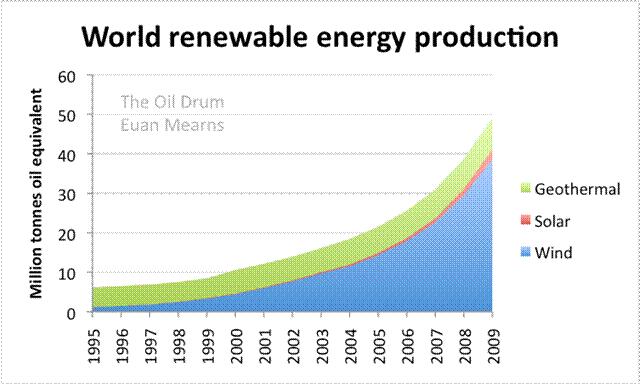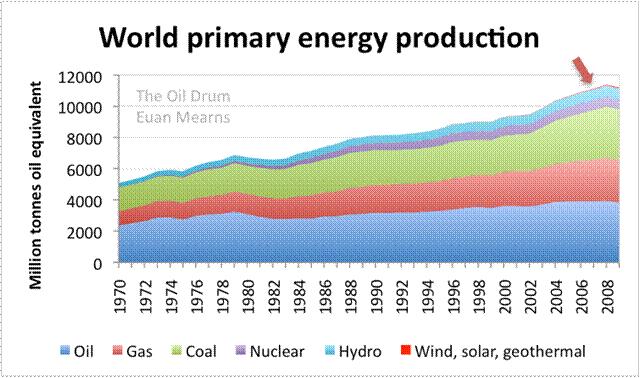Global energy: Renewables to the rescue?
With the tragic Gulf of Mexico oil spill now focussing President Obama's and the American people's minds on where their energy comes from, and what some of the collateral costs might be, its an opportune moment to look at how renewable energy may help supply our future energy needs.
Somewhat ironically, it is BP that provides the energy world with a priceless service through their annual review of world energy that was published last week (with little fanfare) which this year, for the first time, includes data on renewable energy.
Exponential growth in wind energy over the past 15 years has boosted energy from renewables to near 50 million tonnes oil equivalent per annum.
So is this the way to go? Will renewable energy save us from future environmental catastrophes such as the Macondo blow out?
Well I'm sorry if I raised your hopes too high. The chart below shows that global primary energy production is running at about 11,000 million tonnes oil equivalent (MMTOE) per year and that the 50 MMTOE provided by renewables is barely significant - it is the skinny red line marked by the big red arrow.
World primary energy production 1970 - 2009. In 2009, fossil fuels (oil, natural gas and coal) accounted for 87.5% of the energy we used. Wind, solar and geothermal combined accounted for 0.4%. Data source BP 2010.
David Fuller's view On seeing the graph immediately above, I
think many people will question the extent to which they are willing to subsidise
expensive windmills of minimal and unreliable benefit.
Further
research on renewables should be encouraged, not least bio-fuels, which are
not listed in the graph above presumably because they are not classified as
primary energy. To my knowledge, bio-fuels have made little impact on energy
supplies other than in Brazil, which produces them mainly from sugarcane. The
development of algae high in oil content is presumably more promising and less
risky than using foods for energy.
Nevertheless,
renewable energy remains a very long-term solution at best. The graph above
shows us what governments and energy companies need to concentrate on: 1) responsible
development of remaining oil supplies; 2) the development of both conventional
gas and especially shale gas which is a potential game changer if the threat
to groundwater can be minimised; 3) cleaner coal; 4) nuclear energy.
Rather
than subsidise expensive windmills, which are mainly manufactured in China and
require scarce rare earth metals, why not channel that portion of the current
subsidy funds into research on the holy grail of energy - nuclear fusion?
Here is BP's statistical energy report
referred to in Euan Mearns report above.




